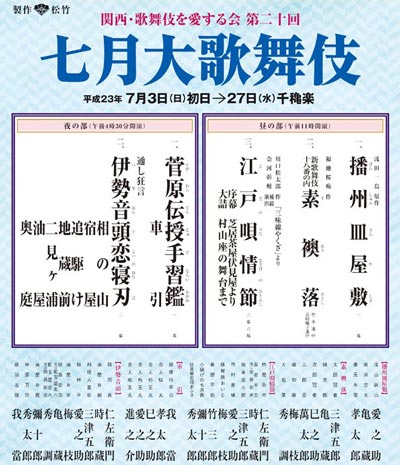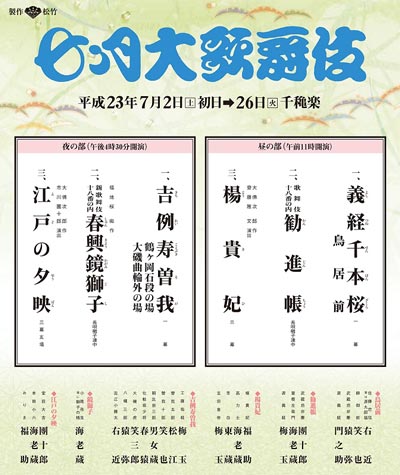| JULY 2011 |
|
4 shows in T˘ky˘ (Shinbashi Enbuj˘, National Theatre, Asakusa K˘kaid˘), 1 in Matsumoto (Matsumoto Performing Arts Centre) and 2 in ďsaka (Sh˘chikuza)!
|
| Sh˘chikuza (ďsaka) |
| Dates | 3 ~ 27 July 2011 (Kansai Kabuki o Ai Suru Kai Shichigatsu ďkabuki) The 20th Kansai Kabuki Lovers Society July Grand Kabuki |
| MatinÚe |
Edo no Uta Nasake no Hitofushi |
| Evening |
Sugawara Denju Tenarai Kagami (Kurumabiki)
|
| Casting |
Kataoka Nizaemon, Band˘ Mitsugor˘, Nakamura Tokiz˘, Kataoka Gat˘, Kataoka Hidetar˘, Kataoka Ainosuke, Kataoka Takatar˘, Band˘ Takesabur˘, Band˘ Yajűr˘, Kataoka Kamez˘, Band˘ Shűch˘, Kataoka Shinnosuke, Nakamura Baishi, Band˘ Minosuke, Nakamura Mantar˘ |
| Comments |
|
 |
| Shinbashi Enbuj˘ (T˘ky˘) |
| Dates | 2 ~ 26 July 2011 (Shichigatsu ďkabuki) July Grand Kabuki |
| MatinÚe |
Yoshitsune Senbon Zakura Y˘kihi |
| Evening | |
| Casting |
Ichikawa Danjűr˘, Nakamura Baigyoku, Ichikawa Ebiz˘, Nakamura Fukusuke, Ichikawa Ukon, Ichikawa Emiya, Ichikawa Emisabur˘, Ichikawa Monnosuke, Ichikawa En'ya, ďtani Tomoemon, Kawarasaki Gonjűr˘, Kataoka Ichiz˘, Nakamura Utae, Ichikawa Unosuke, Nakamura Kikaku, Ichimura Kakitsu, Ichikawa Shun'en, Ichikawa Omez˘, Nakamura T˘z˘, Nakamura Matsue, Ichikawa Juen, Nakamura Shinobu |
| Comments |
|
 |
| National Theatre (T˘ky˘) |
| Dates | 3 ~ 24 July 2011 (Shichigatsu Kabuki Kansh˘ Ky˘shitsu) |
| Program |
Kabuki no Mikata
|
| Casting |
Onoe Sh˘roku, Nakamura Kaishun, Ichikawa Danz˘, Band˘ Kamesabur˘, Band˘ Kametoshi, Onoe Matsuya |
| Comments |
Educational program at the National Theatre called Kabuki Kansh˘ Ky˘shitu ("Kabuki Appreciation Class"). This is a very interesting formula for the beginners because there is lively presentation of Kabuki (or some aspects of the art like music, stage tricks or fighting scenes) on stage, followed by the second act of "Yoshitsune Senbon Zakura":
|
| Matsumoto Performing Arts Centre (Matsumoto) | |
| Dates | 23 ~ 24 July 2011 (Nakamura Kanzabur˘ Tokubetsu K˘en) Nakamura Kanzabur˘ Special Performances |
| Program |
Urashima |
| Casting |
Nakamura Kanzabur˘, Nakamura Senjaku, Nakamura Shichinosuke, Nakamura Kantar˘ |
| Comments |
The Heisei star Nakamura Kanzabur˘ is back on stage!
|
|
|||
| Dates | 12 July 2011 (Onoe Kikunosuke Charitţ Buy˘ K˘en) Onoe Kikunosuke Charity Dance Performances |
||
| Program | |||
| Casting | |||
| Comments |
A special dance program for the victims of the 2011 Great Eastern Japan Earthquake Disaster.
|
||
|
|
| Contact | Main | Top | Updates | Actors | Plays | Playwrights | Programs | Links | FAQ | Glossary | Chronology | Illustrations | Prints | Characters | Derivatives | Theaters | Coming soon | News |